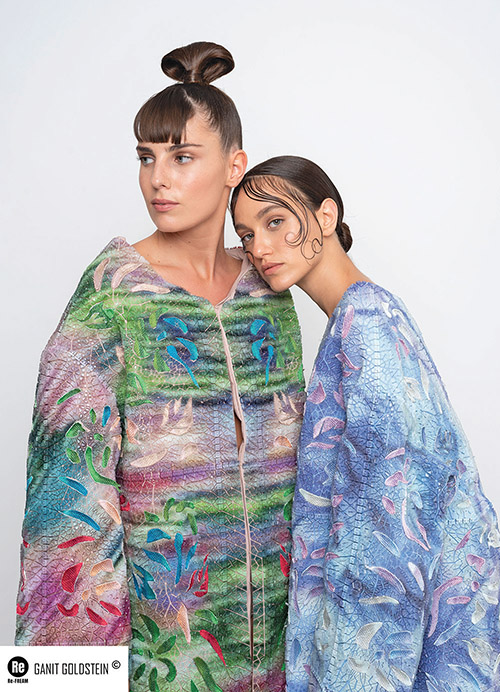



Ganit Goldstein envisions a world in which fashion is more custom and less mass produced. She wants to see women wear fewer outfits with better, lasting quality. She’s on her way to making it happen, with 3D printing and virtual reality to scan body measurements for a perfect fit. In her paradigm, the customer and the environment will both be winners.
Goldstein, an Israeli native, is in London as a second year student earning her master’s degree in smart textile development at London’s Royal College of Art. She has won numerous awards for her collections and shown her work at prestigious exhibitions and museums throughout the world. She has seven collections of clothing and shoes for exhibition only (not for sale).
In a Zoom interview, Goldstein talked about how she is combining the craft of fashion with technology to forge a new method of designing and producing clothes.
Everyone knows the disappointment of a beautiful outfit that simply didn’t fit correctly. Now, imagine a custom designed and produced outfit with Goldstein at the helm. The customer steps on to a platform to have measurements taken with a 360-degree body scanner, from which Goldstein makes a design in parametric software, which translates printable outfits based on the specific measurements.
Then there’s the fabric. Direct-to-textile multicolor 3D printing is at the heart of Goldstein’s designs. She has been working with Stratasys, a manufacturer of 3D printers, to create “a new kind of textile” for a variety of applications.
“With 3D files you can manipulate everything—colors, shapes and features,” she said. “All the files are in 3D format which can be shared easily with partners. We can discuss online, and feel how the garment will be before production. It will all be digitally made. We will be able to customize production, so it will be locally produced instead of mass produced.” The world is changing fast, she said, and she can already make her own prototypes at home on her own 3D printer, often using recycled materials and filaments.
Virtual reality will also transform exhibitions. “You can put on a headset and be in the exhibition space,” she said. “You can walk around a garment see it from all perspectives.”
Her vision may be forward focused but much of her inspiration comes from tradition. She spent a year in Japan studying ikat weaving, a complicated process of precisely dyed yarns woven into a pattern, and then created a collection of outfits inspired by the ikat process. The new collection, WeAreAble, which was launched last month, used 3D printing within textiles in collaboration with Stratasys and home printing production. Funded by Horizon 2020, a European initiative to further innovation and global competitiveness. WeAreAble has been widely shown in Europe. As part of this grant, she was one of 10 artists chosen for a fashion initiative, Re-FREAM 2020, in which artists and designers work with scientists to find new ways to manufacture fashion.
The fusion of fashion and technology began as a family affair for Goldstein. She was studying fashion and jewelry at Bezalel Academy of Art and Design in Jerusalem at the same time her brother was an engineering student and her sister was studying industrial design. The siblings bought a 3D printer to share and Goldstein’s interest was sparked.
Her knowledge of fashion, however, began years earlier. “I was always sewing and making outfits since childhood, but I never thought of it as more than a hobby,” she said. After her army service, she decided to attend art school. “Since then, I’ve been going fast through the process of combining my artistic approach and technological development with worldwide partners and high-tech companies.”
With one year left to graduate and the uncertainty of the pandemic, Goldstein is thinking about her next step. “London has lots of things happening in design—it’s really a global place for the exchange of ideas,” she said. “Israel has lots of collaboration with universities also. We have the same rules for visual communication from the design point of view and atmosphere. I feel that COVID-19 is changing the way we work together, so no matter your location, the technology developments allow for more options to work remotely, but produce locally.”
By Bracha Schwartz
�










